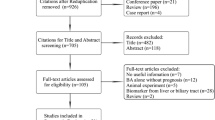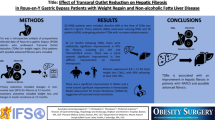Abstract
Purpose
Biliary atresia (BA) is characterized by progressive inflammation of the biliary system. This inflammation persists and causes liver fibrosis, although jaundice disappears after Kasai portoenterostomy (KP). We aimed to confirm whether the oral administration of eicosapentaenoic acid (EPA) suppresses liver fibrosis in postoperative patients with BA.
Methods
We reviewed patients who underwent laparoscopic KP (lapKP) between January 2014 and September 2017. From December 2016, 30 mg/kg/day of EPA was orally administered to patients who opted to take medicine (EPA group). Patients who did not receive EPA were assigned to the non-EPA group. Mac-2 binding protein sugar chain modified isomer (M2BPGi) and hyaluronic acid (HA) levels were compared between the two groups in patients showing disappearance of jaundice at 6 months after the first lapKP.
Results
Seventeen patients in the non-EPA group and 11 in the EPA group were enrolled. At 6 months after the first lapKP, 10 patients in the non-EPA group and six in the EPA group were without jaundice. M2BPGi and HA levels were significantly lower in the EPA group.
Conclusions
Liver fibrosis was suppressed in patients without jaundice 6 months after lapKP, who were administered EPA. We believe that periductular inflammation was alleviated by EPA supplementation.


Similar content being viewed by others
References
Harada K (2017) Sclerosing and obstructive cholangiopathy in biliary atresia: mechanisms and association with biliary innate immunity. Pediatr Surg Int 33(12):1243–1248. https://doi.org/10.1007/s00383-017-4154-8
Kasahara M, Umeshita K, Sakamoto S, Fukuda A, Furukawa H, Uemoto S (2017) Liver transplantation for biliary atresia: a systematic review. Pediatr Surg Int 33(12):1289–1295. https://doi.org/10.1007/s00383-017-4173-5
Sanada Y, Mizuta K, Urahashi T, Ihara Y, Wakiya T, Okada N, Yamada N, Egami S, Ushijima K, Otomo S, Sakamoto K, Yasuda Y, Kawarasaki H (2011) Indication of liver transplantation for jaundice-free biliary atresia with portal hypertension. Ann Transpl 16(4):7–11
Das UN (2006) Essential fatty acids: biochemistry, physiology and pathology. Biotechnol J 1(4):420–439. https://doi.org/10.1002/biot.200600012
Nio M, Sasaki H, Tanaka H, Okamura A (2013) Redo surgery for biliary atresia. Pediatr Surg Int 29(10):989–993. https://doi.org/10.1007/s00383-013-3396-3
Bates MD, Bucuvalas JC, Alonso MH, Ryckman FC (1998) Biliary atresia: pathogenesis and treatment. Sem Liver Dis 18(3):281–293. https://doi.org/10.1055/s-2007-1007164
Nio M (2017) Japanese Biliary Atresia Registry. Pediatr Surg Int 33(12):1319–1325. https://doi.org/10.1007/s00383-017-4160-x
Sumida W, Kaneko K, Ono Y, Tainaka T, Ando H (2009) Different polyunsaturated fatty acid profiles in patients with biliary atresia after successful Kasai operation and liver transplantation. Pediatr Surg Int 25(3):255–259. https://doi.org/10.1007/s00383-009-2324-z
Lee S, Kim S, Le HD, Meisel J, Strijbosch RA, Nose V, Puder M (2008) Reduction of hepatocellular injury after common bile duct ligation using omega-3 fatty acids. J Pediatr Surg 43(11):2010–2015. https://doi.org/10.1016/j.jpedsurg.2008.05.030
Dong R, Zheng S (2015) Interleukin-8: a critical chemokine in biliary atresia. J Gastroenterol Hepatol 30(6):970–976. https://doi.org/10.1111/jgh.12900
Storey A, McArdle F, Friedmann PS, Jackson MJ, Rhodes LE (2005) Eicosapentaenoic acid and docosahexaenoic acid reduce UVB- and TNF-alpha-induced IL-8 secretion in keratinocytes and UVB-induced IL-8 in fibroblasts. J Invest Dermatol 124(1):248–255. https://doi.org/10.1111/j.0022-202X.2004.23543.x
Tang N, Zhang Y, Liu Z, Fu T, Liang Q, Ai X (2016) Correlation analysis between four serum biomarkers of liver fibrosis and liver function in infants with cholestasis. Biomed Rep 5(1):107–112. https://doi.org/10.3892/br.2016.681
Shirabe K, Bekki Y, Gantumur D, Araki K, Ishii N, Kuno A, Narimatsu H, Mizokami M (2018) Mac-2 binding protein glycan isomer (M2BPGi) is a new serum biomarker for assessing liver fibrosis: more than a biomarker of liver fibrosis. J Gastroenterol. https://doi.org/10.1007/s00535-017-1425-z
Yamada N, Sanada Y, Tashiro M, Hirata Y, Okada N, Ihara Y, Urahashi T, Mizuta K (2017) Serum Mac-2 binding protein glycosylation isomer predicts grade F4 liver fibrosis in patients with biliary atresia. J Gastroenterol 52(2):245–252. https://doi.org/10.1007/s00535-016-1235-8
Hasegawa T, Sasaki T, Kimura T, Hoki M, Okada A, Mushiake S, Yagi M, Imura K (2000) Measurement of serum hyaluronic acid as a sensitive marker of liver fibrosis in biliary atresia. J Pediatr Surg 35(11):1643–1646
Author information
Authors and Affiliations
Corresponding author
Rights and permissions
About this article
Cite this article
Sumida, W., Uchida, H., Tainaka, T. et al. Oral administration of eicosapentaenoic acid suppresses liver fibrosis in postoperative patients with biliary atresia. Pediatr Surg Int 34, 1059–1063 (2018). https://doi.org/10.1007/s00383-018-4313-6
Accepted:
Published:
Issue Date:
DOI: https://doi.org/10.1007/s00383-018-4313-6




